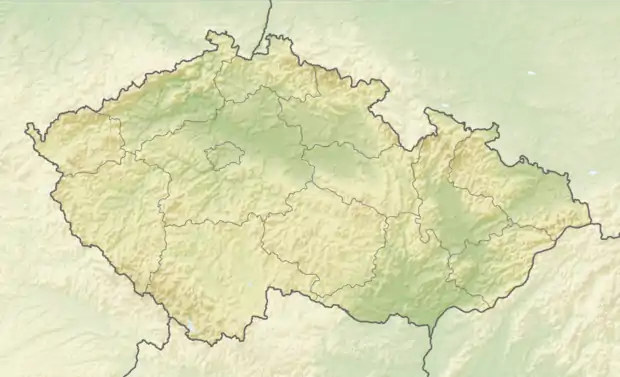Dolní Benešov
Dolní Benešov (Czech pronunciation: [ˈdolɲiː ˈbɛnɛʃof]; earlier also Benešov u Hlučína German: Beneschau) is a town in Opava District in the Moravian-Silesian Region of the Czech Republic. It has around 4,000 inhabitants. The town is a part of the cultural region Hlučín Region.
Dolní Benešov | |
|---|---|
Town | |
 Dolní Benešov seen over the Nezmar pond | |
 Flag  Coat of arms | |
 Dolní Benešov Location in the Czech Republic | |
| Coordinates: 49°55′19″N 18°6′28″E | |
| Country | |
| Region | Moravian-Silesian |
| District | Opava |
| First mentioned | 1312 |
| Government | |
| • Mayor | Martin Štefek |
| Area | |
| • Total | 14.81 km2 (5.72 sq mi) |
| Elevation | 231 m (758 ft) |
| Population (2020-01-01[1]) | |
| • Total | 4,038 |
| • Density | 270/km2 (710/sq mi) |
| Time zone | UTC+1 (CET) |
| • Summer (DST) | UTC+2 (CEST) |
| Postal code | 747 22 |
| Website | www |
History
It was first mentioned in a 1312 deed as an estate of the Benešovice noble family and received town privileges in 1493 by King Vladislaus II. On a ca. 1588 map of Poland and Silesia by G. Mercator it is spelled Benischaw, and spelled Benischow on a ca. 1688 map by N.S. D'Abbeville. The original family name was likely spelled Benis, with the suffix -chaw or -chow meaning domain or town. In an 1812 reference book (A System of Geography, Ancient and Modern by James Playfair, Hill, p. 695) it is spelled Benischau, with a German suffix. On an 1880 map of Silesia it is spelled Beneschau. In 1846 Salomon Mayer Rothschild, who owned the ironworks in nearby Vítkovice, acquired Benešov Palace, probably then spelled Palace Benisowa (of the Benis family).[2]
During World War II, the village, then still known locally as Beneschau, was the base for a working party (E444) of British and Commonwealth prisoners of war, under the administration of Stalag VIIIB/344 at Łambinowice (then known as Lamsdorf) in Poland. In January 1945, as the Soviet armies resumed their offensive and advanced from the east, and the prisoners were marched westward in the so-called Long March or Death March. Many of them died from the bitter cold and exhaustion. The lucky ones got far enough to the west to be liberated by the Allied armies after some four months of travelling on foot in appalling conditions.[3][4][5]
Sport
A local football club, FC Dolní Benešov, plays in the Moravian–Silesian Football League (3rd tier of the Czech football league system).
Twin towns – sister cities
Dolní Benešov is twinned with:[6][7]
 Rajecké Teplice, Slovakia
Rajecké Teplice, Slovakia Wilamowice, Poland
Wilamowice, Poland
Gallery
 Sunset over Nezmar Pond in Dolní Benešov
Sunset over Nezmar Pond in Dolní Benešov
References
- "Population of Municipalities – 1 January 2020". Czech Statistical Office. 2020-04-30.
- "O městě - Dolní Benešov". Dolnibenesov.cz. Retrieved 8 June 2019.
- "STALAG VIIIB 344 LAMSDORF". Lamsdorf.com. Retrieved 8 June 2019.
- "Městský úřad - Dolní Benešov". Dolnibenesov.cz. Retrieved 8 June 2019.
- "Kultura a sport - Dolní Benešov". Dolnibenesov.cz. Retrieved 8 June 2019.
- "Partnerské mestá". rajecke-teplice.info (in Slovak). Rajecké Teplice. Retrieved 2020-09-12.
- "Miejscowości partnerskie". gmina.wilamowice.pl (in Polish). Gmina Wilamowice. Retrieved 2020-09-12.